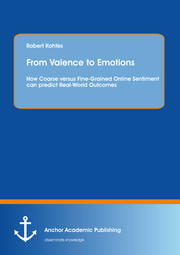-
Zusatztext
-
The growing number of user-generated content that can be found online has led to a huge amount of data that can be used for scientific research. This book investigates the prediction of certain human-related events using valences and emotions expressed in user-generated content with regard to past and current research. First, the theoretical framework of user-generated content and sentiment detection- and classification methods is explained, before empirical literature is categorized into three specific prediction subjects. This is followed by a comprehensive analysis including a comparison of prediction methods, consistency, and limitations with respect to each of the three predictive sources.
-
-
Kurztext
-
The growing number of user-generated content that can be found online has led to a huge amount of data that can be used for scientific research. This book investigates the prediction of certain human-related events using valences and emotions expressed in user-generated content with regard to past and current research. First, the theoretical ...
-
-
Autorenportrait
- Dipl. Kfm. Robert Kohtes, born in 1983, studied Business Administration at the University of Cologne in Germany and at the Asian Institute of Management Manila on the Philippines. During his studies, he specialized in Marketing and Corporate Finance. Currently, he is working on his Doctoral thesis at a well-known German automobile manufacturer. Dipl. Kfm. Robert Kohtes studierte Betriebswirtschaftslehre an der Universität zu Köln und am Asian Institute of Management in Manila. Während seines Studiums setzte er sich intensiv mit den Fragestellungen des Marketings auseinander. Zurzeit forscht er als Doktorand bei einem namenhaften deutschen Automobilkonzern im Bereich Vertriebsstrategie.
-
Leseprobe
- Text Sample:Chapter 4.1.5, Review Site:Even though review sites cannot be seen as a social media application by itself, they have to be considered in this context, because review sites are a valuable data source to gain online sentiments for predicting real-world outcomes. Review ratings appear in a variety of forms they either are embedded into commercial Web pages (e.g., Amazon.com, ebay.com) or appear as exclusive review Web sites specialized in professional or user reviews (e.g., Epinions.com, Cnet.com) (Dave, Lawrence, and Penncock 2003, p. 519; Dellarocas 2003, p. 1408). The area of product or service reviews is complex and includes, for example, car-, electronic-, book-, or movie reviews. On commercial Web sites, the review is directly linked to the product that can be purchased online, whereby on solely review Web sites reviews are sorted by product type and products cannot be purchased directly. Online reviews take the form of either a numerical or graphical rating scale (e.g., 5-star rating), a free text, or a combination of both (Luo and Zhang 2011, p. 13; Dave, Lawrence, and Penncock 2003, p. 521). Through online user ratings, users can recommend or advise against products by posting their experiences and opinions, thereby supporting and influencing other users purchase decisions (OECD 2007, p. 35-40).Because review Web sites cannot be seen as a social media application, a definition according to the seven functional building blocks of social media is not reasonable.4.2, Online Word-of-Mouth:By analyzing the purchase behavior of different household goods, Katz and Lazarsfeld (1955) were the first researchers who found evidence that word-of-mouth (WOM) is the most influential source for consumers to switch a brand, compared to several other means of advertising such as newspapers or radio. WOM is a communication process conveying details about and experiences with a product or service among consumers. Because of the senders independence of the market, WOM is considered as more trustworthy, compared to commercial advertisements or sales persons consulting service (Brown, Broderick, and Lee 2007, p. 4; Jansen et al. 2009, p. 2169; Liu 2006, p. 74). Using social media applications, WOM is no longer spread only among friends, colleagues, and family members offline in a face-to-face manner. Consumers now exchange experiences, recommendations, and knowledge with strangers online by generating OWOM. Review sites, blogs, or social networks, for example, are used to gain and create product or service experiences. Hence, Dhar, and Chang (2009, p. 303) value OWOM generated by consumers as the truest form of word of mouth. Furthermore, OWOM allows exchanging information anonymously or confidentially, which is why it is difficult to control. Thus, OWOM is very important for corporations and organizations with regard to brand management (Jansen et al. 2009, p. 2169).In the following, different forms of OWOM and its technical appearance will be introduced and explained.4.2.1, Appearance of Online Word-of-Mouth:OWOM appears in different forms based on different social media applications on the Internet. Users are able to share their product or service experience in a graphical way or can give advice to other consumers in form of a free text. But not only product experiences are shared online. Trading advice for stock traders can be found online within social media applications as well as cooking or car maintaining instructions.In the following, the most common, and in the upcoming analysis of empirical studies used, OWOM sources are described to give a basic understanding of todays OWOM appearance.
Detailansicht
From Valence to Emotions: How Coarse versus Fine-Grained Online Sentiment can predict Real-World Outcomes
eBook
ISBN/EAN: 9783954896455
Umbreit-Nr.: 6367815
Sprache:
Englisch
Umfang: 78 S., 2.42 MB
Format in cm:
Einband:
Keine Angabe
Erschienen am 01.02.2014
Auflage: 1/2014
E-Book
Format: PDF
DRM: Digitales Wasserzeichen


